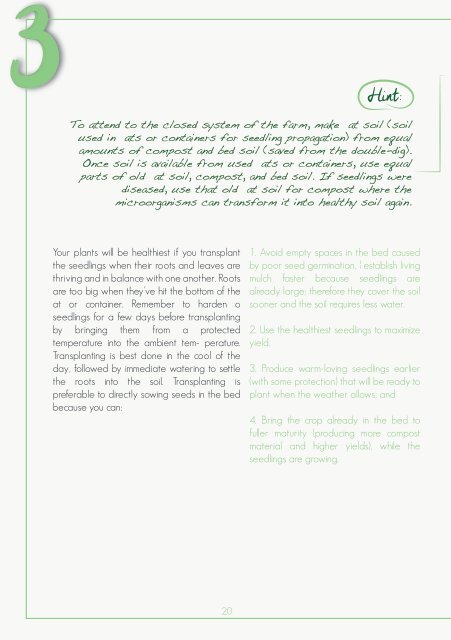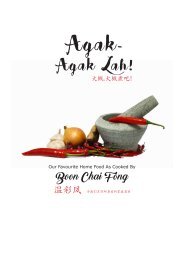Create successful ePaper yourself
Turn your PDF publications into a flip-book with our unique Google optimized e-Paper software.
Hint:<br />
To attend to the closed system of the farm, make at soil (soil<br />
used in ats or containers for seedling propagation) from equal<br />
amounts of compost and bed soil (saved from the double-dig).<br />
Once soil is available from used ats or containers, use equal<br />
parts of old at soil, compost, and bed soil. If seedlings were<br />
diseased, use that old at soil for compost where the<br />
microorganisms can transform it into healthy soil again.<br />
Your plants will be healthiest if you transplant<br />
the seedlings when their roots and leaves are<br />
thriving and in balance with one another. Roots<br />
are too big when they’ve hit the bottom of the<br />
at or container. Remember to harden o<br />
seedlings for a few days before transplanting<br />
by bringing them from a protected<br />
temperature into the ambient tem- perature.<br />
Transplanting is best done in the cool of the<br />
day, followed by immediate watering to settle<br />
the roots into the soil. Transplanting is<br />
preferable to directly sowing seeds in the bed<br />
because you can:<br />
1. Avoid empty spaces in the bed caused<br />
by poor seed germination, ¦ establish living<br />
mulch faster because seedlings are<br />
already large; therefore they cover the soil<br />
sooner and the soil requires less water.<br />
2. Use the healthiest seedlings to maximize<br />
yield.<br />
3. Produce warm-loving seedlings earlier<br />
(with some protection) that will be ready to<br />
plant when the weather allows, and<br />
4. Bring the crop already in the bed to<br />
fuller maturity (producing more compost<br />
material and higher yields), while the<br />
seedlings are growing.<br />
20







